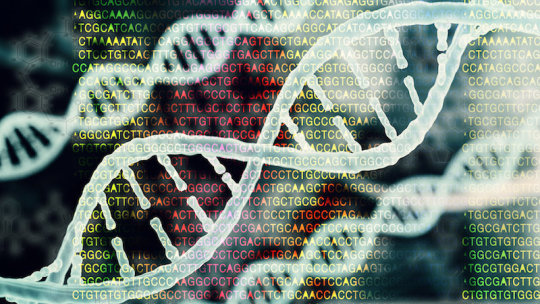Dozens of genes once thought widespread are unique to humans

DNA sequence as art theme/© catalin / Adobe Stock
From ScienceDaily:
Researchers at the Donnelly Centre in Toronto have found that dozens of genes, previously thought to have similar roles across different organisms, are in fact unique to humans and could help explain how our species came to exist.
These genes code for a class of proteins known as transcription factors, or TFs, which control gene activity. TFs recognize specific snippets of the DNA code called motifs, and use them as landing sites to bind the DNA and turn genes on or off.
Previous research had suggested that TFs which look similar across different organisms also bind similar motifs, even in species as diverse as fruit flies and humans. But a new study from Professor Timothy Hughes’ lab, at the Donnelly Centre for Cellular and Biomolecular Research, shows that this is not always the case.
Writing in the journal Nature Genetics, the researchers describe a new computational method which allowed them to more accurately predict motif sequences each TF binds in many different species. The findings reveal that some sub-classes of TFs are much more functionally diverse than previously thought.
“Even between closely related species there’s a non-negligible portion of TFs that are likely to bind new sequences,” says Sam Lambert, former graduate student in Hughes’ lab who did most of the work on the paper and has since moved to the University of Cambridge for a postdoctoral stint.
“This means they are likely to have novel functions by regulating different genes, which may be important for species differences,” he says.
Even between chimps and humans, whose genomes are 99 per cent identical, there are dozens of TFs which recognize diverse motifs between the two species in a way that would affect expression of hundreds of different genes.
“We think these molecular differences could be driving some of the differences between chimps and humans,” says Lambert, who won the Jennifer Dorrington Graduate Research Award for outstanding doctoral research at U of T’s Faculty of Medicine. Paper. (access?) – Samuel A. Lambert, Ally W. H. Yang, Alexander Sasse, Gwendolyn Cowley, Mihai Albu, Mark X. Caddick, Quaid D. Morris, Matthew T. Weirauch, Timothy R. Hughes. Similarity regression predicts evolution of transcription factor sequence specificity. Nature Genetics, May 27, 2019; DOI: 10.1038/s41588-019-0411-1 More.
It’s amazing the difference one percent can make…
See also: A simple statistical test for the alleged “99% genetic identity” between humans and chimps
Copyright © 2019 Uncommon Descent . This Feed is for personal non-commercial use only. If you are not reading this material in your news aggregator, the site you are looking at is guilty of copyright infringement UNLESS EXPLICIT PERMISSION OTHERWISE HAS BEEN GIVEN. Please contact legal@uncommondescent.com so we can take legal action immediately.
Plugin by Taragana
Michael J. Behe's Blog
- Michael J. Behe's profile
- 219 followers



